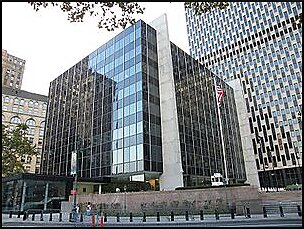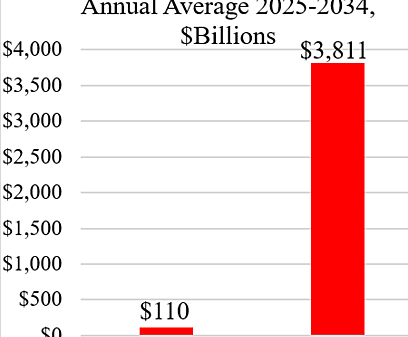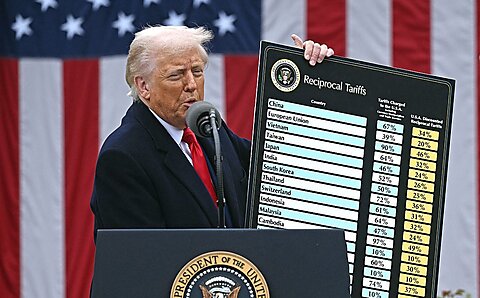Jeremy Horpedahl and Phillip W. Magness
While the Trump administration had already rolled out tariff increases against our largest trading partners—Canada, Mexico, and China—several weeks ago (and then delayed some of them), we finally got a picture of President Trump’s big tariff plans on April 2. And those plans are worse than most economists probably imagined.
At his announcement of the tariffs, Trump pulled out a printed table of data, showing the supposed tariff rates that countries were charging the US, as well as the supposed “reciprocal” tariffs that the US was imposing (generally half of what they claimed was being charged against the US). In Trump’s telling, the new rates aim to offset the tariff and non-tariff barriers (NTBs) that each country allegedly imposes against American goods.
Despite the president’s rhetoric about “reciprocity,” the White House’s numbers immediately didn’t add up. While the US and EU don’t have a free trade agreement, there is no way the average tariff rate the EU charges the US is 39 percent. And for South Korea, who we do have a free trade agreement with, Trump’s chart claimed they are charging us a 50 percent tariff rate. In fact, many of the countries that Trump singled out for “reciprocal” tariffs score above the United States on conventional measures of trade freedom.
The White House chart did say that the figures include “currency manipulation and trade barriers,” and initially it seemed there was some sophisticated formula being used to calculate the rates. Not so. As several users on X/Twitter quickly figured out, and the White House later confirmed, their “reciprocity” formula is a simple one. It’s also nonsensical from an economic standpoint.
According to the White House’s calculations, Trump is claiming the “tariff” a country is charging the US is equal to the trade deficit between the countries, divided by the imports into the US (for goods only, not services). He then sets his “reciprocal” rate according to this back-of-the-envelope formula.
That’s it. This supposed “reciprocal tariff” is then, for unclear reasons, divided by 2 (because Trump is a nice guy, giving them a discount?), yielding the rate that Trump says he will be applying to almost every country and political jurisdiction on earth. If the resulting number is less than 10 percent, then Trump still sets a minimum tariff rate of 10 percent. Even if the US has a trade surplus with a country, they get a 10 percent tariff. Everyone, it seems, gets at least a 10 percent tariff, but certain countries get a steeper tariff if their trade deficit with the United States is larger.
It’s unclear who is responsible for devising this formula. The White House statement credits it to the Council of Economic Advisers; however, online chatter has suggested it may have come from Chat GPT. Oren Cass, a protectionist tariff activist at American Compass, also appeared to claim responsibility in a thread on X. The “official” White House formula appeared in a post on the United States Trade Representative (USTR) website, coinciding with Trump’s “Liberation Day” press conference. The USTR formula appears to be little more than economic alchemy. It sets “reciprocal tariffs” by incorrectly assuming that “persistent trade deficits are due to a combination of tariff and non-tariff factors that prevent trade from balancing.” Its purported calculation consists of little more than the amateur arithmetic described above, albeit with the component data points represented in Greek letters to give it the appearance of scientific sophistication.
One particularly egregious error in the USTR’s formula comes from its underlying parameters, which assume that the “elasticity of import prices with respect to tariffs, φ, is 0.25.” They justify this number by citing a 2021 paper in the journal American Economic Review: Insights, yet appear to have misread both its parameters and its main finding, namely that “so far, the tariffs’ incidence” from Trump’s previous term in 2018 “has fallen in large part on US firms.”
Despite these efforts to dress up the new tariff schedule in the language of economics, one thing is certain. The White House’s “reciprocity” calculation has no basis in mainstream economic analysis. Instead, it seems to have been improvised on the fly as a rationalization for Trump’s pre-existing intention of levying heavy tariffs on almost all of our trading partners.
There are a host of legal issues that arise from this approach, both on the international level. For example, the US appears to be violating almost every trade agreement they have signed, including those negotiated by Trump during his first term. On the domestic level, Trump’s actions likely go way beyond the president’s power to impose tariffs, which comes from a narrow delegation of Congress’s exclusive constitutional authority to set tax rates. But put all those legal issues aside—there is a huge economic issue.
Trump and his team have fallen prey to one of the most basic economic fallacies: that a trade deficit is bad. But what is a trade deficit? It means that a country imports more goods from one country than it exports to that same country. But there is no reason to assume that all trade will balance—we might want, say, a lot of bananas from countries that have climates hospitable to growing them, while those countries may not demand any of the goods that we produce. The trade is still mutually beneficial: we want bananas, they want income. Nothing nefarious is going on, and there is no reason to think all trade will balance.
These tariff increases are likely to be some of the biggest tax increases in US history and will result (if fully implemented) in some of the highest tariff rates the US has ever seen—possibly even exceeding the notorious Smoot-Hawley tariff of 1930, which contributed to the Great Depression.
Like all tariffs, some large portion of these new levies will be paid by US consumers and businesses in the form of higher prices. Trump’s stated goal is to help American workers, but it will do the opposite. And it won’t lead to an American manufacturing renaissance, as the US is still producing, by most measures, near record amounts of manufactured goods. We just don’t need as many workers to produce that output, thanks to massive efficiency gains (a big part of why we are so rich today).
Finally, Trump’s tariff plan has many indications that this plan was thrown together at the last minute, without much consideration of the logic or consequences. On the hilarious side, Trump included some islands near Antarctica that are only inhabited by penguins on his list of countries that will get a 10 percent tariff. Slightly more seriously, the 20 percent tariff on all EU countries doesn’t even follow his formula—the US has trade surpluses with several EU member states, such as Spain and Belgium. But most importantly, there isn’t any good economic theory to support Trump’s reciprocal tariff plan. The formula appears to be merely a justification to put tariffs on all countries, but higher ones on countries that we import a lot from.













